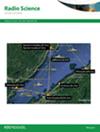Design and characterization of the engineering model of the spectrometer onboard LuSEE-Night
IF 1.6
4区 地球科学
Q3 ASTRONOMY & ASTROPHYSICS
引用次数: 0
Abstract
The Lunar Surface Electromagnetics Explorer—Night, LuSEE-Night, is a low-frequency radio astronomy experiment that will explore the cosmic Dark Ages signal on the radio-quiet farside of the Moon. The LuSEE-Night carries a radio frequency spectrometer consisting of a set of antennas, analog and digital processing electronics, and will be launched by NASA's Commercial Lunar Payload Services in 2025. The spectrometer is designed to observe the spectrum of the radio sky in the 0.5–50 MHz band. The engineering model (EM) of the four-channel spectrometer has been developed. The EM has been characterized for linearity, gain, noise, and their temperature dependence, confirming that the EM meets all the requirements for LuSEE-Night. Three mitigation techniques have been implemented and verified to suppress self-induced electromagnetic interference. The flight model of the spectrometer is currently being developed and is scheduled to be shipped to the integration site in early 2024.设计和鉴定 LuSEE-Night 星上光谱仪的工程模型
月球表面电磁学探索者之夜(LuSEE-Night)是一项低频射电天文学实验,将在无线电静默的月球远端探索宇宙黑暗时代的信号。LuSEE-Night携带一个射频频谱仪,由一组天线、模拟和数字处理电子设备组成,将于2025年由美国宇航局的商业月球有效载荷服务发射。该频谱仪旨在观测 0.5-50 兆赫频段的射电天空频谱。四通道光谱仪的工程模型(EM)已经开发出来。已对工程模型的线性度、增益、噪声及其温度依赖性进行了鉴定,确认工程模型符合 LuSEE-Night 的所有要求。为抑制自发电磁干扰,实施并验证了三种缓解技术。目前正在开发分光计的飞行模型,计划于 2024 年初运往集成地点。
本文章由计算机程序翻译,如有差异,请以英文原文为准。
求助全文
约1分钟内获得全文
求助全文
来源期刊

Radio Science
工程技术-地球化学与地球物理
CiteScore
3.30
自引率
12.50%
发文量
112
审稿时长
1 months
期刊介绍:
Radio Science (RDS) publishes original scientific contributions on radio-frequency electromagnetic-propagation and its applications. Contributions covering measurement, modelling, prediction and forecasting techniques pertinent to fields and waves - including antennas, signals and systems, the terrestrial and space environment and radio propagation problems in radio astronomy - are welcome. Contributions may address propagation through, interaction with, and remote sensing of structures, geophysical media, plasmas, and materials, as well as the application of radio frequency electromagnetic techniques to remote sensing of the Earth and other bodies in the solar system.
 求助内容:
求助内容: 应助结果提醒方式:
应助结果提醒方式:


